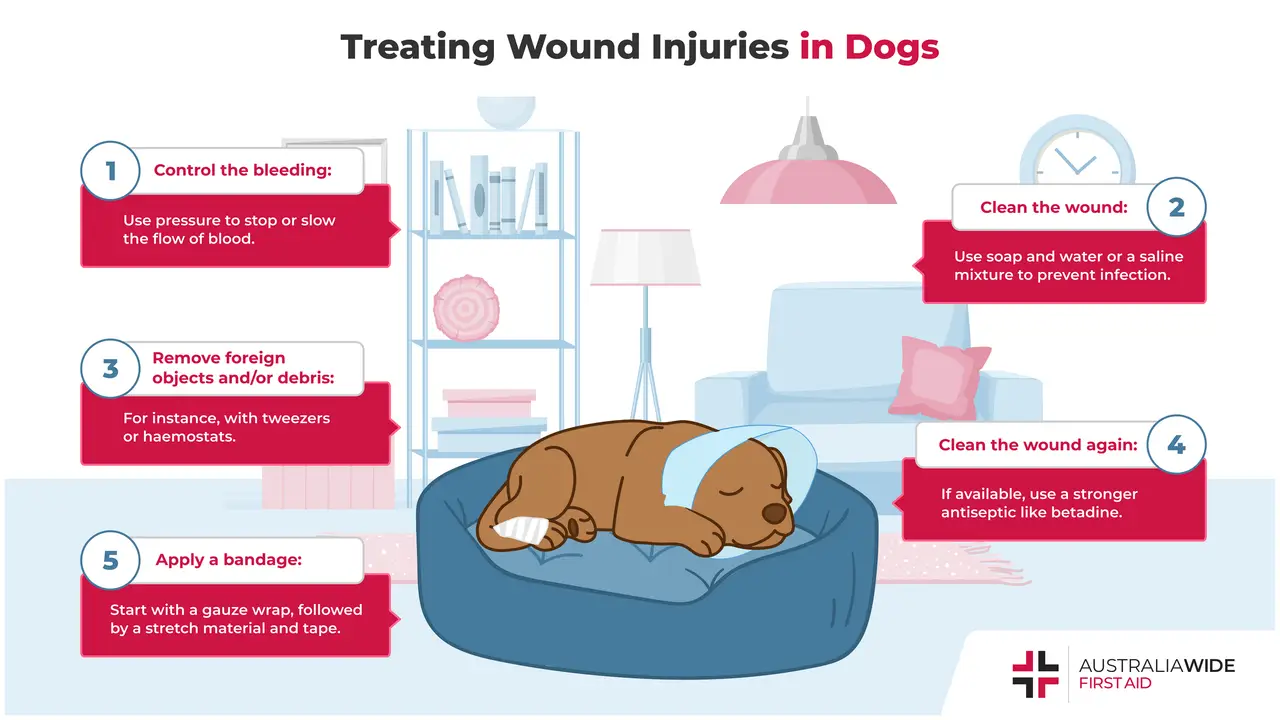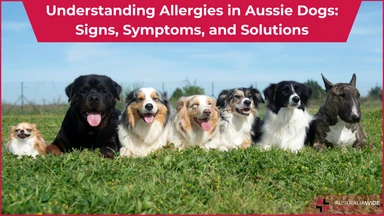First Aid: Wound Care for Dogs


Wound care refers to therapy and treatment for a puncture, abrasion, and/or musculoskeletal injury.
Dogs may incur wounds in natural settings, during animal encounters, from exercise, or by accident at home. A wound injury can be a frightening experience for pet owners, especially for someone without first aid training.
Fortunately, wound treatment in dogs is very similar to wound treatment in humans aside from a few minor differences. Educating yourself on basic first aid for your dog can help you treat your pet at home or buy time for you to seek out professional assistance.
In this article, we will review the types of wound injuries your dog may have, first aid treatment, and dog-specific approaches to wound care.
Your first steps after an injury are to assess the safety situation, then identify the type of injury your dog sustained.
Are you able to safely access your dog or are there threats that need to be addressed first? Is your dog acting aggressively in response to the trauma? Address any safety concerns before attempting to administer first aid.
Help your dog to a comfortable and safe space where you can access your supplies and administer first aid.
Wound injuries may be in the form of abrasions, open bone fractures, puncture wounds, lacerations, or burns.
Monitor the site for bleeding. Venous injuries (injury to a vein) are typically slow, dark red, and possibly oozing. Arterial injuries (injury to an artery) will have bleeding that is strong, bright red, and might be pulsing. Arterial injuries are more dangerous.
Check the site for the presence of foreign objects.
Now that you have brought your dog to a safe space and assessed the injury, it is time to provide first aid using the following 5 steps:
Apply a non-stick pad (like Telfa pads) to the site of injury
Apply padding and pressure over the injury to stop bleeding.
Wrap the affected area. If the injury is on a leg or foot, wrap in a figure-8 pattern. If you have a variety of bandaging materials on hand, wrap first with gauze, then with a stretch material, like an ACE wrap, over the top. Apply tape over the bandage to stabilize the wrap. Avoid bandaging too tight as this can restrict blood flow.
Note: When wrapping the foot, push the foot into its weight-bearing position so that the wrap is not too tight when the foot returns to its natural standing position.
Wounds should be properly cleaned as soon as possible to prevent bacterial infection. The first cleaning of the wound should be done with soap and clean water or a saline mixture.
DIY Saline mixture: 1 cup of water with ½ tsp of non-iodized salt. Boil for 15 minutes with a lid on the pot.
Next, remove debris and any foreign objects, then clean the wound again. It may be appropriate during the second wound cleaning to use a disinfectant such as chlorhexidine or betadine if available. Follow the instructions on the bottle for use. If you have antibiotic ointments, such as Neosporin, apply them to the wound after cleaning.
Wound care must be performed as soon as possible after the injury and maintained once or twice a day until healed.
For less serious wounds, maintenance wound care may only involve changing the outer bandage when soiled. For more serious wounds, you may need to change the entire bandage once or twice a day and reapply an antibiotic ointment.
Seek guidance from a licensed veterinarian for maintenance wound care of more serious wounds or for wounds that are not improving.
For more information on pet first aid, check out our article library. You may enjoy reading:

April 16, 2024
Like humans, our canine friends are susceptible to allergies, which can significantly affect their quality of life. This article aims to shed light on common allergies in dogs, their signs and symptoms, treatment options, and advice on when to consult a veterinarian.

March 19, 2024
From respiratory distress to changes in droppings and abnormal behaviours, this guide outlines the key indicators of illness that require immediate attention. By understanding these warning signs, bird owners can take proactive steps to ensure their feathered companions receive timely medical treatment, ultimately promoting their health and well-being.

February 12, 2024
In the hustle and bustle of our daily lives, it's easy to overlook that our furry friends may not be leading lives as fulfilled as we'd like. Just like humans, dogs too can suffer from monotony, especially those spending large amounts of time indoors. Recognizing and addressing boredom in our canine companions is crucial for their overall well-being.